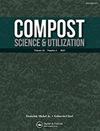蚯蚓与农业废弃物复合的成熟度和CH4、N2O、NH3排放
IF 0.9
4区 农林科学
Q3 ECOLOGY
引用次数: 24
摘要
摘要本研究研究了蚯蚓与农业废弃物堆肥的成熟度和气体排放。以番茄茎为处理对象,以牛粪为营养基质,接种粪Eisenia fetida进行蚯蚓堆肥处理,为期50 d。采用不接种蚯蚓的嗜热堆肥处理作为对照处理。试验期间测定了温度、pH、C/N比、萌发指数(GI)等成熟指标,并连续测定了蚯蚓生物量和CH4、N2O、NH3排放量。结果表明:蚯蚓堆肥温度适宜蚯蚓生存,蚯蚓生物量由10.0 kg m−3增加到63.1 kg m−3;蚯蚓堆肥达到堆肥成熟度标准(GI为80%)的平均时间较亲热堆肥短,堆肥产品GI为132%。此外,蚯蚓堆肥中碳氮比的降低表明垃圾趋于稳定。蚯蚓的活动对蚯蚓堆肥气体排放具有积极作用,其NH3排放量(初始氮的12.3%)和总温室气体排放量(8.1 kg CO2-eq/t DM)低于嗜热堆肥(24.9%初始氮的NH3- n, 22.8 kg CO2-eq/t DM)。综上所述,蚯蚓堆肥可以缩短达到堆肥成熟所需的时间,获得较好的成熟堆肥,同时减少气体排放。作为一个额外的优势,处理后的蚯蚓可以有商业用途。本文章由计算机程序翻译,如有差异,请以英文原文为准。
The Maturity and CH4, N2O, NH3 Emissions from Vermicomposting with Agricultural Waste
ABSTRACT This study investigated the maturity and gaseous emissions from vermicomposing with agricultural waste. A vermicomposting treatment (inoculated Eisenia fetida) was conducted over a 50-day period, taking tomato stems as the processing object and using cow dung as the nutrient substrate. A thermophilic composting treatment without earthworm inoculation was operated as a control treatment. During the experiment, maturity indexes such as temperature, pH, C/N ratio, and germination index (GI) were determined and continuous measurements of earthworm biomass and CH4, N2O, and NH3 emissions were carried out. The results showed that the temperature during vermicomposting was suitable for earthworm survival, and the earthworm biomass increased from 10.0 to 63.1 kg m−3. Vermicomposting took less time on average to reach the compost maturity standard (GI 80%), and reached a higher GI (132%) in the compost product compared with the thermophilic composting treatment. Moreover, the decrease of the C/N ratio in vermicompost indicated stabilization of the waste. The activities of earthworms played a positive role in reducing gaseous emissions in vermicompost, resulting in less emissions of NH3 (12.3% NH3-N of initial nitrogen) and total greenhouse gases (8.1 kg CO2-eq/t DM) than those from thermophilic compost (24.9% NH3-N of initial nitrogen, 22.8 kg CO2-eq/t DM). Therefore, it can be concluded that vermicomposting can shorten the period required to reach compost maturity, can obtain better maturity compost, and at the same time reduce gaseous emissions. As an added advantage, the earthworms after processing could have commercial uses.
求助全文
通过发布文献求助,成功后即可免费获取论文全文。
去求助
来源期刊

Compost Science & Utilization
农林科学-生态学
CiteScore
4.10
自引率
0.00%
发文量
0
审稿时长
>36 weeks
期刊介绍:
4 issues per year
Compost Science & Utilization is currently abstracted/indexed in: CABI Agriculture & Environment Abstracts, CSA Biotechnology and Environmental Engineering Abstracts, EBSCOhost Abstracts, Elsevier Compendex and GEOBASE Abstracts, PubMed, ProQuest Science Abstracts, and Thomson Reuters Biological Abstracts and Science Citation Index
 求助内容:
求助内容: 应助结果提醒方式:
应助结果提醒方式:


